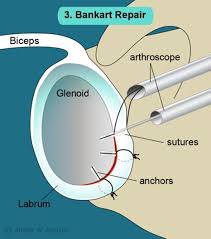-
Mon - Sat
08:00am - 08:00pm


The Bankart lesion is an injury of the glenohumeral joint. This is a ball-and-socket joint that binds the scapula and the humerus. Parts of the joint are the labrum, a fibrocartilaginous structure around the glenoid, the capsule, ligaments and supporting muscle tendon
The shoulder is designed for its mobility, with stability being sacrificed to achieve this mobility. Due to poor osseous congruency and capsular laxity, the glenohumeral joint is very unstable, which makes it the most frequently dislocated joint in the human body. It relies on dynamic stabilizers and the neuromuscular system for its stability. Anterior instability is the most common traumatic type of instability, representing approximately 95% of all shoulder instabilities. Glenohumeral dislocations are mainly caused by an abduction, extension and external rotation movement.
In many cases of anterior dislocation patients have a Bankart lesion.
Patients with a Bankart lesion are recognized by shoulder pain which is not localized in a specific point and the pain gets worse when the arm is held behind the back. They also feel weakness and instability of the shoulder
Many patients who sustain a shoulder dislocation will sustain a Bankart lesion.
For the identification of a Bankart lesion you can use Magnetic Resonance Imaging (MRI).
A multiple dislocation will need a 3D CT scan to identify any bony loss.
Arthroscopic repair with suture anchors is an effective surgical technique for the treatment of an isolated Bankart lesion. Open repair does not always show us a significant improvement of functions of the shoulder.
Risk factors are having an age under 25 years, ligamentous laxity, and with a large (>250 mm³) Hill-Sachs lesion.
Arthroscopic repair: A suture anchor is placed medially to the fracture on the glenoid neck, and its sutures are passed around the bony fragment through the soft tissue including the inferior glenohumeral ligament complex. The sutures of this anchor are loaded in a second anchor that is placed on the glenoid face. This creates a nontilting 2-point fixation that compresses the fragment into its bed. By use of the standard technique, additional suture anchors are used superiorly and inferiorly to the bony Bankart piece to repair the labrum and shift the joint capsule. This way of surgery successful restores the shoulder stability with a high patient satisfaction.